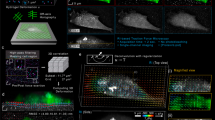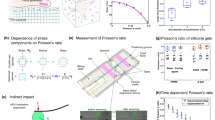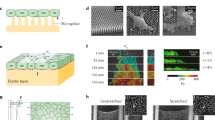Abstract
The atomic force microscope can detect the mechanical fingerprints of normal and diseased cells at the single-cell level under physiological conditions1,2. However, atomic force microscopy studies of cell mechanics are limited by the ‘bottom effect’ artefact that arises from the stiff substrates used to culture cells. Because cells adhered to substrates are very thin3, this artefact makes cells appear stiffer than they really are4. Here, we show an analytical correction that accounts for this artefact when conical tips are used for atomic force microscope measurements of thin samples. Our bottom effect cone correction (BECC) corrects the Sneddon's model5, which is widely used to measure Young's modulus, E. Comparing the performance of BECC and Sneddon's model on thin polyacrylamide gels, we find that although Sneddon's model overestimates E, BECC yields E values that are thickness-independent and similar to those obtained on thick regions of the gel. The application of BECC to measurements on live adherent fibroblasts demonstrates a significant improvement on the estimation of their local mechanical properties.
This is a preview of subscription content, access via your institution
Access options
Subscribe to this journal
Receive 12 print issues and online access
$259.00 per year
only $21.58 per issue
Buy this article
- Purchase on Springer Link
- Instant access to full article PDF
Prices may be subject to local taxes which are calculated during checkout




Similar content being viewed by others
References
Lee, G. Y. H. & Lim, C. T. Biomechanics approaches to studying human diseases. Trends Biotechnol. 25, 111–118 (2007).
Costa, K. D. Single-cell elastography: probing for disease with the atomic force microscope. Dis. Markers 19, 139–154 (2003–2004).
Lekka, M. & Laidler, P. Applicability of AFM in cancer detection. Nature Nanotech. 4, 72 (2009).
Dimitriadis, E. K., Horkay, F., Maresca, J., Kachar, B. & Chadwick, R. Determination of elastic moduli of thin layers of soft material using the atomic force microscope. Biophys. J. 82, 2798–2810 (2002).
Sneddon, I. N. Fourier Transforms Ch. 10 (McGraw-Hill, 1951).
Lekka, M. et al. Elasticity of normal and cancerous human bladder cells studied by scanning force microscopy. Eur. Biophys. J. 28, 312–316 (1999).
Cross, S. E., Jin, Y-S., Rao, J. Y. & Gimzewski, J. K. Nanomechanical analysis of cells from cancer patients. Nature Nanotech. 2, 780–783 (2007).
Cross, S. E. et al. AFM-based analysis of human metastatic cancer cells. Nanotechnology 19, 384003–384011 (2008).
Li, Q. S., Lee, G. Y., Ong, C. N. & Lim, C. T. AFM indentation study of breast cancer cells. Biochem. Biophys. Res. Commun. 374, 609–613 (2008).
Lekka, M. et al. Cancer cell recognition—mechanical phenotype. Micron 44, 1259–1266 (2012).
Prabhune, M. et al. Comparison of mechanical properties of normal and malignant thyroid cells. Micron 43, 1267–1272 (2012).
Kuznetsova, T. G. et al. Atomic force microscopy probing of cell elasticity. Micron 38, 824–833 (2007).
Cross, S. E., Jin, Y-S., Rao, J. & Gimzewski, J. K. Applicability of AFM in cancer detection. Nature Nanotech. 4, 72–73 (2009).
Rico, F. et al. Probing mechanical properties of living cells by atomic force microscopy with blunted pyramidal cantilever tips. Phys. Rev. E 72, 021914 (2005).
Kang, I. et al. Changes in the hyperelastic properties of endothelial cells induced by tumor necrosis factor-α. Biophys. J. 94, 3273–3285 (2008).
Kihara, T., Haghparast, S. M. A., Shimizu, Y., Yuba, S. & Miyake, J. Physical properties of mesenchymal stem cells are coordinated by the perinuclear actin cap. Biochem. Biophys. Res. Commun. 409, 1–6 (2011).
McElfresh, M. et al. Combining constitutive materials modeling with atomic force microscopy to understand the mechanical properties of living cells. Proc. Natl Acad. Sci. USA 99 (Suppl 2), 6493–6497 (2002).
Alcaraz, J. et al. Microrheology of human lung epithelial cells measured by atomic force microscopy. Biophys. J. 84, 2071–2079 (2003).
Raman, A. et al. Mapping nanomechanical properties of live cells using multi-harmonic atomic force microscopy. Nature Nanotech. 6, 809–814 (2011).
Pogoda, K. et al. Depth-sensing analysis of cytoskeleton organization based on AFM data. Eur. Biophys. J. 41, 79–87 (2012).
Petrie, R. J., Gavara, N., Chadwick, R. S. & Yamada, K. M. Nonpolarized signaling reveals two distinct modes of 3D cell migration. J. Cell Biol. 197, 439–455 (2012).
Gavara, N. & Chadwick, R. S. Noncontact microrheology at acoustic frequencies using frequency-modulated atomic force microscopy. Nature Methods 7, 650–654 (2010).
Wong, J. Y., Velasco, A., Rajagopalan, P. & Pham, Q. Directed movement of vascular smooth muscle cells on gradient-compliant hydrogels. Langmuir 19, 1908–1913 (2003).
Butt, H. J. & Jaschke, M. Calculation of thermal noise in atomic force microscopy. Nanotechnology 6, 1–7 (1995).
Acknowledgements
The authors thank R. Sunyer, V. Luo and K.M. Yamada for critical input. This work was supported by the Intramural Program of the US National Institute of Deafness and Other Communication Disorders.
Author information
Authors and Affiliations
Contributions
N.G. conceived, designed and performed the experiments and analysed the data. R.S.C. developed the BECC correction. N.G. and R.S.C. co-wrote the paper.
Corresponding author
Ethics declarations
Competing interests
The authors declare no competing financial interests.
Supplementary information
Supplementary information
Supplementary information (PDF 1602 kb)
Rights and permissions
About this article
Cite this article
Gavara, N., Chadwick, R. Determination of the elastic moduli of thin samples and adherent cells using conical atomic force microscope tips. Nature Nanotech 7, 733–736 (2012). https://doi.org/10.1038/nnano.2012.163
Received:
Accepted:
Published:
Issue Date:
DOI: https://doi.org/10.1038/nnano.2012.163
This article is cited by
-
Correlation between biological and mechanical properties of extracellular matrix from colorectal peritoneal metastases in human tissues
Scientific Reports (2023)
-
3D nanomechanical mapping of subcellular and sub-nuclear structures of living cells by multi-harmonic AFM with long-tip microcantilevers
Scientific Reports (2022)
-
FluidFM for single-cell biophysics
Nano Research (2022)
-
Machine learning method for extracting elastic modulus of cells
Biomechanics and Modeling in Mechanobiology (2022)
-
Atomic force microscopy for revealing micro/nanoscale mechanics in tumor metastasis: from single cells to microenvironmental cues
Acta Pharmacologica Sinica (2021)



